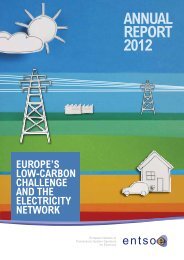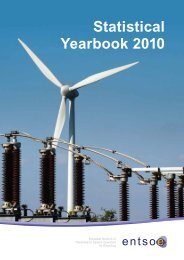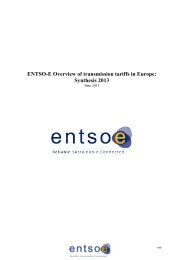Performance of Generating Plant - World Energy Council
Performance of Generating Plant - World Energy Council
Performance of Generating Plant - World Energy Council
Create successful ePaper yourself
Turn your PDF publications into a flip-book with our unique Google optimized e-Paper software.
<strong>Performance</strong> <strong>of</strong> <strong>Generating</strong> <strong>Plant</strong>: Managing the Changes Executive Summary <strong>World</strong> <strong>Energy</strong> <strong>Council</strong> 200712Table 3 Land area required for different renewable power plantsSource: WEC and US DOE<strong>Energy</strong> source Wind Solar (PV) Biomass GeothermalLand area for a 1 GW plant100 km²but can be used foragricultural purposes30 km²but panels can beinstalled on ro<strong>of</strong>s5000 km² 200 km²biomass actually delivered only 1% <strong>of</strong> the globalelectricity, far behind fossil fuels (66.4%), largehydro (16.2%), and nuclear (15.2%).Europe and North America are the two leaderswith almost 75% <strong>of</strong> the global bioelectricityproduction ahead <strong>of</strong> Asia (about 18%) and Africawith only 0.2%.Wood and other biomass materials can beprocessed and used to generate electricity.There are three major transformations presentlyin use: combustion, gasification and pyrolysis <strong>of</strong>biomass.Combustion is the most common way <strong>of</strong>converting solid biomass fuels to energybecause <strong>of</strong> the low cost and high reliability.Gasification and pyrolysis are still underdevelopment but are generally expected tobecome more common in the future.Biomass is a part <strong>of</strong> the renewable energyportfolio and it can <strong>of</strong>fer an array <strong>of</strong> benefits:• No greenhouse gases during the life cycleand lower overall emissions than fossilfuelplants• Forest sustainability• <strong>Energy</strong> independence and regionalintegration• Proven technologies for combustion andco-firing• Use <strong>of</strong> low-cost productsBiomass systems are most <strong>of</strong>ten fuelled bywaste wood, from logging operations, forestthinning, low-grade wood or sawmill residues,which are far too frequently burnt in the openwithout pollution control. These systems createa commercial market for wood, while alsoboosting the forestry economy.Moreover, biomass cultivation can reduce therisk <strong>of</strong> wildfires by removing small diameter treesthat act as a fuel. It prevents harmful effects <strong>of</strong>forest fires on the atmosphere, including release<strong>of</strong> mercury, toxic materials, GHGs and NOx.Biomass conversion to electricity providessignificant benefits, but is also has several majordrawbacks:• Seasonal availability• Transport and processing• Emissions• Land area requirementThe land area that is required for exploitation bya biomass power plant is huge when comparedto other energies. Table 3 shows this land arearequired for exploitation <strong>of</strong> a 1GW renewableenergy plant (average values).Theoretically biomass energy has enormouspotential. The long-term biomass electricityproduction potential is estimated at 11,000TWhper year, i.e. more than 60% <strong>of</strong> the worldwideelectricity production in 2005 (18,140TWh). Thispotential is higher than that <strong>of</strong> other renewableenergies: hydro (7,500 TWh), wind energy(around 4,500 TWh), Solar energy (4,400 TWh).However, biomass must be divided amongst alluses (food, heating, electricity, bio-fuels).













